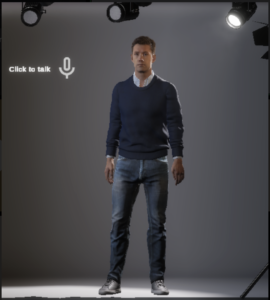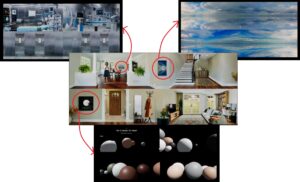
Hi everybody! I am Nathan Williams and my job at Northwestern University, Illinois USA, is to allow you to familiarize yourself with how to interact with intelligent avatars and handle interactive objects before you enter their e-REAL medical simulation room. If you want to find out all about the new e-REAL interactive scenarios, read here!
Introducing an interactive simulation
On the DigiBlog you’ve met an introductory digital human before, the Montgomery College Raptor, so you should know what I’m talking about when I say that my role is to guide the participants through a simulation. Although I do introduce the Northwestern University medical simulation room, my role is actually a bit different than the Raptor’s one. In fact, I’m not part of the medical simulation myself, as my scenario is played on a completely different interactive wall at the beginning of the long corridor that takes you to the simulation room. I’m kind of doing my own thing and I truly love my independence.
I welcome the participants when they arrive and make sure that they have all the necessary information about where they are and what they are about to do. As I’m an intelligent digital human, I’m able to answer any questions they might have and thus I make the presence of a real human being unnecessary. Of course, my human colleagues are always welcome to stand besides me if they want!
My scenario is also kind of unconventional, as it’s not set anywhere that relates to the simulation the participants are going to engage too shortly after. The stage I’m on represents a place where participants can experiment and try their interaction skills in a playful way before they are actually involved in the big thing, but I’ll tell you more about it later.
Finally, there is one thing I have to admit: I’m just a placeholder. That’s right, I was a quick fix – ok, defining the development of a digital human as “quick” is definitely wrong, but some do take less time than others – to have someone fill this position until the e-REAL team has time to transform one of you humans in a digital being. Who will it be? I can’t tell, I was sworn to secrecy. Just know that if you’ve been in the Northwestern University medical simulation room you might have heard his name a time or two…

Scenarios with interactive objects
I’ve just told you that my scenario is playful, and you might think that yeah, gamification is quite a recurrent topic in e-REAL interactive scenarios, but that’s not it. I meant that you can literally play around with objects. Now, before you think that we’ve gone completely mad and forgot our educative mission, let me keep you on the right track: it’s an educational playing around. By interacting with my scenario participants learn how to use interactive walls on different levels.
The first thing they understand is the most basic one, that is that the white circle that appears under their hand is how they interact with the wall itself. But that’s of course not all. On the right of the stage there are some balloons that can be dragged around. They demonstrate how to move interactive objects in the digital space. On the left of the stage on the other hand, there are some cursors to control the three stage lights above me. By changing their setting, you can see how interactive components can impact the digital space, for example by making it very bright, very light, or by shifting my shadow. All this has no purpose other than give the participants a feeling of the kind of simulations they are going to be using in the simulation room. Last, but not least, there is the icon which makes me listen to what they are saying. They have to activate it in order to talk to me, otherwise it’s like I’m deaf. You should see how often the e-REAL team forgets to touch that button when testing intelligent digital humans, talking to a wall can become quite literal then. Of course, once they figure out how to ask me questions, the participants can train a bit how to better formulate them to get the exact information they need from me. Who is smarter, the human or the AI? Now I’m just joking, don’t mind me too much. Here, take a look at this video to see how my scenario works.
The future of e-REAL interactive scenarios
Although my scenario has been created to experiment with interactive functions, it’s a representation of what the future holds for e-REAL interactive simulations. The new interactive objects introduce a huge realm of possibilities that goes well beyond playing with balloons and tampering with the lights.
You’ve met Venessa, my digital colleague at Northwestern University, and I’m going to explain to you how a now seeming less feature in her simulation might actually hold the key for a future network of interconnected e-REAL scenarios and simulations.
You might have noticed in her house some rather peculiar paintings hanging on the walls. Her taste is impeccable, so why should she have a weird OR picture hanging in her dining room? Since we are at the beginning of this brand-new chapter, they too are now still more fur fun than for actual educational purposes, but I assure you, in the future, they will be. These paintings are like portals, you touch them, and they transport you to the interactive content they depict. That’s how you can move from Venessa’s home to the simulation of a hospital operating room with just one simple interaction. And now imagine how with a system like this, one could travel from scenario to scenario, from simulation to simulation, in a huge, interconnected e-REAL world. No more closing one scenario to open another, just one touch and you can start a new journey.

As much as I’ve enjoyed out little talk, I have to go now. If you have any questions I might help you with, you know where to find me. And if I’m not available, the DigiBlog will always be here next week to introduce you to a new character!
